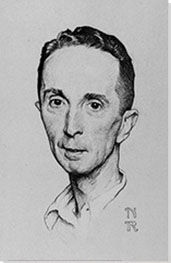Summary of Norman Rockwell
Rockwell presented the world with the definitive picture of what it meant to be "all-American". He is remembered chiefly for his 47-year association with The Saturday Evening Post weekly, for whom he painted over 320 cover images, and his long-standing connection with the Boy Scouts of America, for whom he provided artworks for its annual calendar for most of his working years. His preoccupation with the minutiae of the daily lives of the American nuclear family, not to mention his vital contribution to the World War II propaganda effort, have seen him achieve American icon status.
Preferring to be thought of as a genre painter (rather than an illustrator), he is best known perhaps for a particular type of painting rather than for specific works and, not unlike Edward Hopper, his vision of the American small town has seeped into the nation's collective consciousness. Though his unabashed patriotism and pictorial style made him an easy target for avant-gardists and left-wing intellectuals, his later work revealed the influence of Social Realism and several of his mature pieces, especially those he produced for Look magazine, took on a more socio-political edge. History has, quite rightly, tended to be very appreciative of Rockwell's contribution to the pictorial arts in America and his nostalgic images continue to adorn calendars, post-cards, posters and other arts ephemera.
Accomplishments
- A religious and traditional thinker, Rockwell was above all else a patriot. His was a sympathetic and optimistic view of the average American and he, more than any other artist in its history, captured the daily customs and rituals of the comely ways of traditional American family life.
- Though "dismissed" by some as an illustrator, Rockwell executed his scenes with humor and respect for his subjects, and with an attention to detail that, in his words, would make the spectator "want to sigh and smile at the same time." Painting at a time when abstract art was coming to the fore, Rockwell remained convinced that his positive and unambiguous images trumped the self-indulgences of abstract experimentation.
- The champion of Abstract Expressionism, Clement Greenberg, was one of those who condemned Rockwell's work for being sentimental and commercial and he criticized the artist because he "chose not to be serious." But Rockwell was deeply serious about his art. His position was perhaps best summed up by his own granddaughter, Abigail Rockwell when she wrote: "Some say life will never be as perfect as life in a Norman Rockwell painting. But my grandfather's work isn't about an unachievable ideal. Pop's work is about believing in the goodness of people. It's about finding that goodness in ourselves and others and in the moments we spend with one another."
- Though Rockwell maintained that he always "wanted to entertain" his late period paintings often promoted "causes" such as freedom of speech and the Civil Rights Movement. Even his more overtly sentimental paintings started to acknowledge shifting class and gender roles while he remained a strong advocate of democratic values and the acceptance of all races and religions throughout his adult life.
- In the same way that, for example, Vermeer and Caravaggio used the camera obscura as an aid to producing their compositions, so Rockwell would use photography to capture an image of his sitters. Though his models were nearly always friends of acquaintances, Rockwell rotated a small squad of photographers who would record, under his direction, scenes that the painter himself would compose. Much to the chagrin of purists who believed that art should always be produced "freehand," Rockwell would, with the aid of a projector, trace and sketch the images onto his canvas before composing his intricate narrative paintings.
The Life of Norman Rockwell
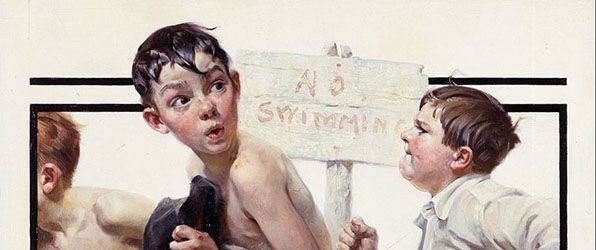
A look at the work of Norman Rockwell belies the man behind the images. Strangely, one biographer described him as “a twice-divorced workaholic who neglected wives and children, a religious nonbeliever, a closeted homosexual, a depressive forever anxious”. But, that is probably an exagerated account, as such a conflicted character would have problems in producing some of the most optimistic and idealized images in American history.
Important Art by Norman Rockwell
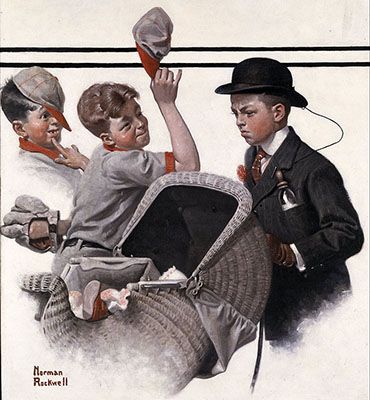
Boy With Baby Carriage
Boy With Baby Carriage was Rockwell's first Post cover. Typical of his earlier montage paintings, this humorous boyhood coming-of-age theme is a fine example of his skill at capturing the gentle travails of human experience. The three figures and wicker carriage are positioned against a blank background so as to direct most of our attention onto the human figures in the composition. In this respect, the main "action" in the painting is created by the facial expressions of the boys. Rockwell created a simple, stark image relying on black, white and grey with touches of red to bring our attention to the boys' faces. It was his attention to details like this, and simple, but felt empathy with his subjects that so endeared Rockwell to the American public. Other illustrators of Norman Rockwell's time period, including Robert Gunn, Robert Tannenbaum and Leslie Thrasher, tried to imitate his style but failed to capture the essence of their characters or to emulate Rockwell's sixth sense for time and place.
Magazine editors were quick to recognize the human touch in Rockwell's exceptional compositions. The Post's art editor Kenneth Stuart, commented for instance that "No guide is needed for Norman's work" since the "warmth of his understanding reaches [the] People [who] experience his paintings." Stephanie Plunkett, chief curator at the Norman Rockwell Museum, backed that view when she said that for Americans Rockwell presented a picture of "who we are, what we could be, what we could look like [and] what our values could be."
Oil on Canvas - Norman Rockwell Museum, Stockbridge, Massachusetts
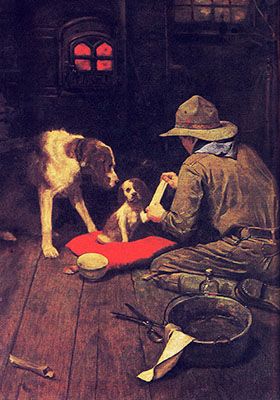
A Red Cross Man in the Making
The Red Cross Red Crescent Magazine, the official magazine for a movement of the same name, is published by international groups in Geneva and Switzerland, and is written in six languages. The organization is humanitarian and dedicated to protecting the lives and dignity of victims of armed conflict. This painting was originally painted for the magazine to exemplify the good will of a Red Cross man, seen here in the guise of a scout attending to a small dog that has suffered an injury. It was also chosen to be used as Rockwell's first calendar cover for the Boy Scouts of America. Rockwell, always a keen observer of his world and its issues, captured the realities of individual lives as well as the mores held dear by society. In many of his paintings, he promotes personal responsibility, patriotism, heroism, gender equity and/or racial integration which he saw as the foundations of the American way.
In A Good Scout, Rockwell used a series of diagonal lines and a dramatic plan of light and dark to pull the viewer's attention to the small, forlorn dog resting on a red pillow in the center of the composition. The larger dog and the young man are also posed in angled positions to complete the grouping while the dark areas surrounding the figures keep our attention on the animals and the boy's helping hands are placed in the very center of the composition. The use of softly glowing areas which seem to disappear into the darkness is not unlike the technique of Rembrandt, an artist whom Rockwell admired greatly. The old dented pot filled with water, the scissors and a small glass bottle in the foreground introduce us to the event in the middle ground while the strong red shapes in the background, perhaps a wood or coal stove, seem to glow with warmth. Great attention was also given to the scout's uniform with the textured and banded hat, kerchief, his belt with key ring and study shoes with precisely detailed soles.
Oil on Canvas - Boy Scouts of America
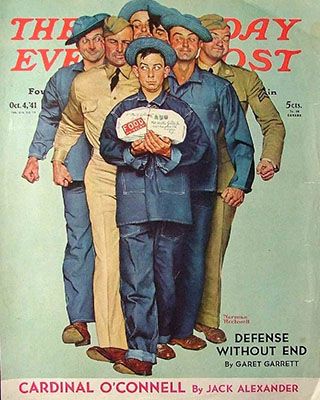
Willie Gillis Food Package
Rockwell first introduced Willie Gillis as a fictional character in the first of a series of World War II propaganda paintings. Eleven of these were used as magazine covers by the Post between 1941 and 1946. As a boyish private, Willie charmed the American public from his induction through discharge, and boyhood through manhood; he became a highlight of Rockwell's wartime work. Rockwell described Gillis as "an inoffensive, ordinary little guy thrown into the chaos of war". Many Post subscribers assumed that Rockwell's Willie Gillis was a real person which encouraged them to further support the war bond effort. The artist's intent was to infuse a sense of duty, patriotism and optimism for those young American gentlemen going to war.
Carefully holding a white package with a red label, "FOOD", Willie glances anxiously to his right. War zone tradition dictated that any package from home was to be shared among the troops. Seven muscular officers are tightly grouped behind him and looking expectantly at the small package. The men are older, taller and dressed in uniforms of a higher rank. Rockwell deliberately presented these six determined men as one solid form in the center of the composition as a worrisome pressure for Gillis. Their expressions range from happily expectant to grimly resolved as they march with purpose and vigor behind Willie and his package. The five blue uniforms and the different angles of the caps are arranged to bring our eyes into and around the dense grouping which is also broken up by the tan uniforms. The four swinging arms with clenched fists help separate the men and create some space behind Willie. It is a very simple, shallow composition but it is full of gentle humor as the expression on Willie's face suggests that he would prefer not to share his bounty with his companions!
Oil on Canvas - Location Unknown
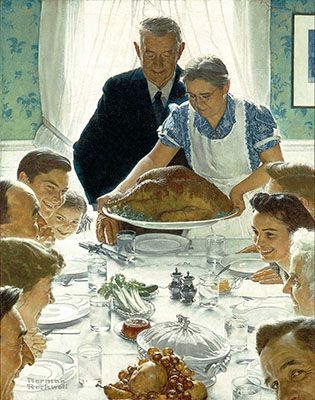
Freedom From Want
Freedom From Want is the third painting in a series of four called the Four Freedoms and is considered by many to be one of Rockwell's finest works. The series was inspired by President Franklin Roosevelt's January 1941 Four Freedoms State of the Union Address to Congress through which he identified four essential human rights - freedom from want; freedom from fear; freedom of speech; freedom of worship - which needed to be universally protected. Rockwell's paintings were published in 1943 in the Post, accompanied by essays commissioned from writers including Booth Tarkington, Will Durant, Carlos Bulosan and Stephen Vincent Benet. When the Four Freedoms paintings were first published, the Post, received a deluge of requests for reprints. The government was amongst the requestees and millions were distributed in connection with the Treasury Department's War Bond drives. Rockwell's paintings showed up as posters in post offices, schools, railroad stations, and other public and semi-public buildings.
Freedom from Want was composed using a wide angle view of a large happy family ready to enjoy a lavish meal. All the characters were family members or friends whom Rockwell photographed separately before painting them as a group gathered in his living room in Arlington, Virginia. A grandmother wearing an apron is shown carefully setting down a large platter holding a large turkey while the grandfather looks on with proud approval. The painting, sometimes known as I'll Be Home for Christmas, symbolized Rockwell's hopes for a post-war period and as such it presented an idealized vision of America as a rural and agricultural haven. Art critic and biographer Deborah Solomon described this composition as offering "a new level of descriptive realism. Yet the painting doesn't feel congested or fussy; it is open and airy in the center." The extensive array of delicately detailed and modeled dishes, glasses and serving items are framed by the many individual faces. One of the faces is even turned toward the viewer, as if to include us in the celebration.
Oil on Canvas - National Archives, College Park, Maryland
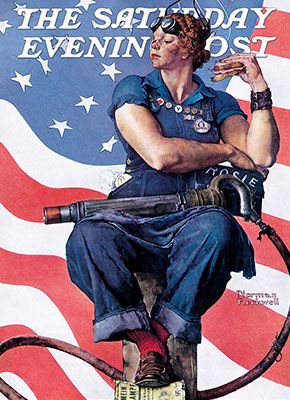
Rosie the Riveter
Rosie the Riveter was representative of the many women working in factories and shipyards during World War II. Their role, previously occupied by men who had been recruited to the armed forces, was to produce war supplies and to build and maintain the US air fleet. The female workers were invaluable to the US war effort and Rosie inspired women to give up their domestic roles and to seek work in the factories. The painting was used as the cover illustration for the Post on Memorial Day, May 29, 1943. The strong, proud woman is depicted with a ham sandwich in her left hand and a rivet gun resting across her lap. She is posed against an image of the American flag. Hitler's derided manifesto, Mein Kampf, is the footrest under her shoe which is an iconic American loafer.
Rockwell borrowed Rosie's strident pose from Michelangelo's Sistine Chapel ceiling painting of the prophet Isaiah. His usual interest in textures and details, meanwhile, are embodied in her socks, a Red Cross pin and a V for Victory pin. It seems likely that the painting was influenced by the 1943 song "Rosie the Riveter" by John Jacob Loeb and Redd Evan which carried the same patriotic message. Indeed, the painting is still used today by feminists as a symbol of female empowerment.
Rosie herself was in fact a Vermont resident, Mary Doyle O'Keefe, who worked as a telephone operator close to Rockwell's home. In later years, O'Keefe said she was pleased to have helped with the effort for the war bond drive: "I was very pleased [...] I am proud of this painting. It's a symbol of what women did for the war, to do their part, and to give up their nail polish." (O'Keefe added later that she did pose with a ham sandwich, used a plastic toy machine gun but never saw a copy of Hitler's Mein Kampf!).
Oil on Canvas - Crystal Bridges Museum of American History, Bentonville, Arkansas
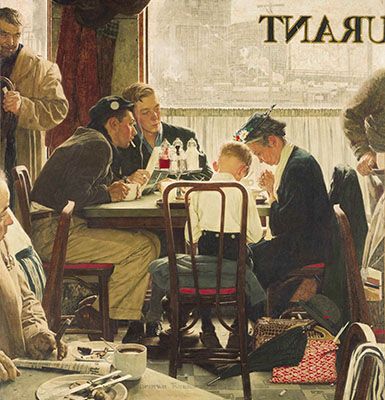
Saying Grace
A middle-aged woman and a young boy, seated at a crowded table in a noisy diner, take time out to pray before eating. The two young men sat at their table stare at them while other diners turn to observe them also. This was Rockwell's message: we share a world where many different people exist and we can live in harmony if we show respect for others' beliefs. Rockwell clearly felt that the American people had a collective source of strength and a heartfelt prayer of gratitude for the gift of love.
Post readers voted Saving Grace their favorite magazine cover of the 1950s. The poll was taken shortly after Thanksgiving and the poll victory seemed to symbolize the central importance of "the Holy" in so many national celebrations. The painting was accompanied by the text "Our world is not the happy place these days" and was meant to comfort Americans during the period of readjustment in the post-war period. In its narrative, ordinary Americans could find faith in love and kindness and the strength to trust in others.
The composition, very carefully and tightly planned, was staged in real life at a café near Times Square in Manhattan. In fact, Rockwell first brought the furniture from the café to his studio and made photographs to use for later reference. He used the deep focus photographic technique - whereby foreground, middle ground and background are in equally sharp focus - to stage the scene. The result is a very busy, but well-balanced, depiction of an interior space with the fine picture detail rendered in color and shadow. Our eyes are invited to enter the story on the lower left where the edge of a table leads us to a man reading his newspaper and glancing over towards the praying customers. The table for four, occupying the middle ground of the composition, makes a center feature of the boy's white shirt while the background is the net-curtained front window with a city railroad scene beyond. All additional and personal items are painstakingly detailed and employ touches of color, such as repeated areas of white, tan, red, dark brown and black. Even the smallest personal items are included in Rockwell's scheme, such as the lady's hat, the collection of glass condiment containers and the umbrella, carry bags and the boy's hat on the floor. In December 2013, the painting sold for $46 million dollars in a bidding war, an American record and twice the estimated value.
Oil on Canvas - Private Collection
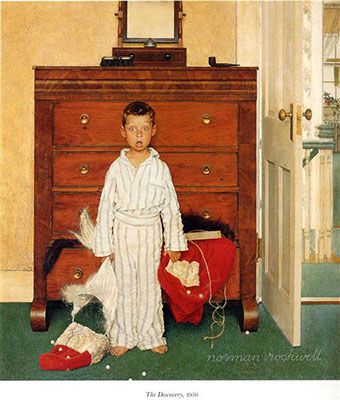
The Discovery
While Rockwell would continue to paint for The Post for a further seven years, The Discovery proved to be the last of his seasonal (and quite popular) covers. Confirming his technical virtuosity, this work marked a subtle shift towards a greater thematic realism. Here for instance Rockwell seems undeterred by the fact that his image - which humorously captures the shock of realization on the face of a young boy on discovering his father's hidden Santa Claus costume - might reveal the myth of Saint Nicolas to innocent children.
In 2007, the Akron Art Museum celebrated its new building expansion with the premiere of a "blockbuster" touring exhibition: American Chronicles: The Art of Norman Rockwell. Director of Curatorial Affairs, Barbara Tannenbaum stated that "Rockwell was able to express what it means to be American with a directness and vitality that no other artist in our history has ever matched" and she counted The Discovery amongst his "greatest and most moving works." His biographer, Deborah Solomon, observed however that Rockwell had been "demonized by a generation of critics who not only saw him as an enemy of modern art, but of all art." One might add that his art was under-representative of such a racially and culturally diverse nation. That criticism notwithstanding, Tannenbaum suggested that Rockwell's "beautiful" painting stood proud as a "wonderful lesson in both history and techniques and [of the] processes that remain vital" to the genre of narrative painting.
Oil on canvas - Collection of Norman Rockwell Museum, Stockbridge, Massachusetts
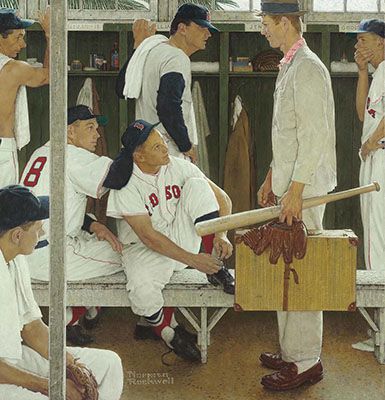
The Rookie
Rockwell painted The Rookie, also known as The Rookie (Red Sox Locker Room), for the March 2, 1957 cover of The Saturday Evening Post. The scene depicts some of the Boston Red Sox team members in their locker room. A new player has arrived dressed in a rumpled tan suit carrying a brown suitcase, baseball bat and glove. During the summer of 1956, Rockwell convinced the Red Sox management to send him four players from the starting line up to Stockbridge Massachusetts, deep in Red Sox country. The team members did not even know who Rockwell was at the time. For authenticity, Rockwell invited the catcher Sammy White, the pitcher Frank Sullivan, right fielder Jackie Jensen and Billy Goodman, the versatile baseman, to his studio to pose for photographs. He also had a local high school baseball star, Sherman Stanford, pose as the new rookie player. The actual Red Sox spring training site was in Payne Park, Sarasota, Florida so Rockwell visited there to take photographs of the team's locker room.
The players stare at the rookie with apprehension. The player on the right edge of the painting has his right hand covering his mouth, perhaps stifling a laugh or in disbelief. The only one smiling, rather tentatively admittedly, is the rookie himself. Like many of Rockwell's characters, The Rookie champions the underdog during a time of challenge. There is an autobiographical element to the painting too since Rockwell often felt that he was an underdog in his younger life. He did not possess many of the athletic qualities admired in young boys and teenagers, nor was he tall, strong or socially adept.
Rockwell posed the figures meticulously to lead our eyes to the rookie through the many angles created by their postures, their profiles, the different slants of their shoulders and the dark baseball caps. The player seated on a bench directly in front of the rookie, in the center of the composition, captures our attention since his is the most complicated, actively angled pose. He looks directly up into the rookie's smiling face with a questioning expression. All of the light and dark areas of activity are balanced by one vertical on our left and the horizontal bands running across the composition: the lockers, windows, bench and the rookie's suitcase.
Oil on Canvas - Private Collection
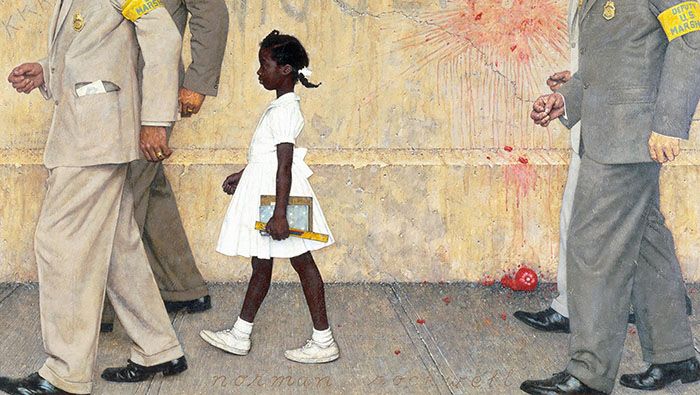
The Problem We All Live With
This painting depicts Ruby Nell Bridges (who in adult life joined the board of the Norman Rockwell Museum) a six-year old African American girl, being escorted to her New Orleans school on her very first day by four United States Marshals. Her assigned school, The William Franz Elementary School, was one of two all-white public schools where desegregation was implemented in 1960. As a consequence, the school personnel experienced race riots and death threats against the black children. It took more than ten years for the New Orleans public schools to fully integrate and even longer for the local Catholic Schools to follow suit.
The Problem We All Live With became an iconic image of the Civil Rights Movement in the United States. On the wall behind the walking figures are written slurs, including the word "nigger", the acronym "KKK" and the remnants of a smashed tomato which angry protesters would have thrown at the group. This painting was Rockwell's first for LOOK magazine and it was published as a centerfold in the January 14, 1964 issue. The little girl is the focal point of the composition but she is balanced by the blood red splotch of the remains of the tomato. The strong juxtaposition of the light areas versus the dark areas, especially the bright white of her dress with her dark skin, is complemented by neutral tan and brown areas punctuated by the crisp black shoes. Rockwell prepared by taking photographs of legs walking, some wearing pants, in order to capture the patterns of folds and creases in the pants of the faceless forces of justice: the United States Marshalls.
In 2012, an intern, Devan Casey, at the Norman Rockwell Museum in Stockbridge, Massachusetts, recounted reading a letter on display near the painting from a man in Tennessee, Chester Martin, who thanked Rockwell for showing him the severity of the situation. Mr. Martin had written: "I have never been so deeply moved by a picture [...] Thank you for showing this white Southerner how ridiculous he must look." Yet, many such letters were sent that were not at all complimentary such as one from G.L. Lebon from New Orleans who wrote: "Anybody who advocates, aids or abets the vicious crime of racial integration is nothing short of a traitor to the white race." People of all types across the country were paying attention; despite entrenched prejudices against his "conservative" outlook, Norman Rockwell demonstrated that he could in fact generate strong emotions through social commentary. In 2011, President Barack Obama displayed the painting at the White House as part of the 50th anniversary of Bridges's walk into history.
Oil on Canvas - Norman Rockwell Museum, Stockbridge, Massachusetts
Biography of Norman Rockwell
Childhood and Education
Norman Percevel Rockwell was the second of three sons born to Jarvis Waring Rockwell, the manager of a Philadelphia textile company, and Anne Mary Rockwell, an anxious but adventuresome wife, mother and homemaker. His parents were very religious and he and his brothers spent many hours with the choir at St. Luke in the Fields in Greenwich Village. During summer months, the family lived in New England on country farms. Rockwell stated in his autobiography "I have no bad memories of my summers in the country [and they] had a lot to do with what I painted later on." Even as a young boy, he learned to admire the farm families' open expressiveness and enjoyed the calm of milking the cows which contrasted with his busy city life.
The young Norman Rockwell enjoyed drawing from an early age so his father sat drawing with him and his younger brother, Jerry, many nights at the family dining table. Jarvis had a fine mastery of perspective and form which he had developed by copying from popular illustrated magazines. Primary school lessons, meanwhile, did not make much sense to Norman even though the school encouraged drawing and coloring. However, when Norman was about 8 years old, his father began reading the novels of Charles Dickens to the boys and Norman was transfixed. He began drawing pictures of Dickens's characters and later reflected "I began to look around me [...] to look at things the way I imagined Dickens would have looked at them."
While Norman was still just 8 years old, his grandmother passed away and he and his family moved to Manhattan to live with his grandfather (known affectionately to the family as Father Rockwell). Norman was behind other boys of his age in physical prowess and the New York City schools stressed athletic activities at the time. He tried weight exercises but could not correct his gawkiness and pigeon-toed gait. He later commented on his situation: "All I had was the ability to draw, which as far as I could see didn't count for much. But [...] I began to make it my whole life [...] My feelings no longer paralyzed me." The young Norman still felt he fell short of the model American male, however, and having the middle name Percevel contributed to his insecurities.
Early Training
By the time Norman reached teenage years, his extended family had moved out of New York City to Mamaroneck, NY. Their new home was in a pleasant, sleepy village near enough to the Atlantic Ocean to hear the waters lap. His school and church life proved less tedious and more relaxed too. Norman started to meet new friends with whom he enjoyed a strong camaraderie. Old enough to understand the financial strains of his family, Norman decided to make some money; he mowed lawns, bought a mail delivery route to the wealthy area of the village and began tutoring. He tutored several students in algebra, drawing and painting including Ethel Barrymore, later regarded as "The First Lady of the American Theatre". At the age of 14, Norman began taking art classes at The Chase School of Art where he had his first instruction in the history of art which brought him knowledge of James McNeill Whistler and John Singer Sargent.
Within two years, he was even more secure about his intent to pursue his passion and he dropped out of high school, enrolling in the National Academy of Design at his own expense. Later he transferred to the Art Students League of New York to study with Thomas Fogarty and George Bridgman. Fogarty specialized in illustration which prepared Rockwell for early commercial commissions. Bridgman, meanwhile, taught him further technical skills for life studies.
Fogarty helped Rockwell find his first professional commission: a chance to illustrate twelve "Tell-Me-Why" stories which were early parent-child interactive storybooks. He found a studio in Brooklyn Heights near the Brooklyn Bridge large enough to share with Ernest Blumenschein, one of his illustration teachers. At the Art Students League, he enrolled in one drawing course and also attended the National Academy of Design for Life Studies and Illustration. In late 1912, when Rockwell was 18, Thomas Fogarty recommended that he show his work to Edward Cave who had recently been appointed to fully develop Boys' Life magazine as a national publication. Cave gave Rockwell two preliminary assignments with which to prove himself; one was to create a camping guide for the Boy Scouts; the other to continue his contributions for Boys' Life until he had created four hundred illustrations. At 19, Rockwell became the art editor for Boys' Life, published by the Boy Scouts of America.
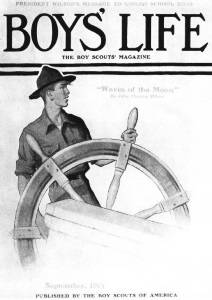
Around the same time, Rockwell convinced his family to move to New Rochelle, New York, which was a more sophisticated setting and home to several well-known artists including Joseph C. Leyendecker. He soon developed some fine friendships and found a new studio space. In 1914, Rockwell had become friends with Clyde Victor Forsythe, an older fellow boarder and cartoonist, who also worked for Boys' Life. The more experienced artist believed fully in Rockwell's talent and they rented Frederic Remington's old iron barn as their studio. Forsythe urged his friend to submit his work to the Saturday Evening Post; in fact, Rockwell had often longed to see his work as the cover of the popular magazine. Between the end of May 1916 and January 1917, Rockwell's paintings were used for six weekly issues of the magazine. In 1916, meanwhile, Rockwell met Irene O'Connor, a school teacher three years his senior - she accepted his impulsive proposal. The marriage was not easy however since Irene expected him to have a regular work schedule and wanted his companionship for many social events.
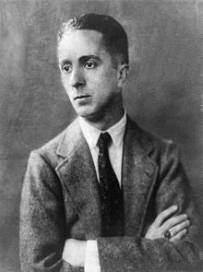
Between 1916 and 1919 Rockwell created some twenty-five Saturday Evening Post covers, and many story illustrations. He had already become a national phenomenon with Life magazine featuring him in a full-page advertisement for new subscriptions. Rockwell considered Life to be the "greatest show window in America" yet his rapid success left the 25 year old feeling exhausted. Having taken time out to recuperate, by 1920 Rockwell's illustrations began to show more painterly sophistication than his earlier figures which were caricature-like. His new approach seems to have reflected Bridgman's life drawing instruction and his new work gained him respect among the famous illustrators who resided in New Rochelle. He became good friends with Leyendecker, whom he admired personally and professionally. While Rockwell ambled through the village streets, he would look for the best models for each character in his artwork. Rockwell's friend and studio mate, Clyde Forsythe, remarked that whenever his schedule seemed overwhelming, he would take an unplanned trip but would also worry that his clients would forget about him.
In 1922 Rockwell decided to study abroad and traveled to Paris for a few weeks to attend art school and to visit museums and galleries. His short tour took him on to southern France, Italy and Switzerland. After his return to America, Rockwell made several paintings on the theme of travel. One portrayed an ordinary office worker absorbed in reading a postcard sent from abroad while another showed a young boy viewing scenes of exotic places. The theme of escape became a prominent feature of his work during the 1920s and 1930s.
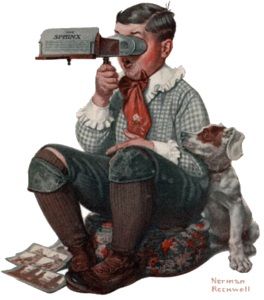
Rockwell had been painting the annual covers for the conservative Boy Scout Calendar for several years, but by 1924 he had grown weary of this commission. However, once he had raised his concerns with the publisher, they offered Rockwell a highly lucrative new contract. On the back of his new found affluence, Rockwell made the decision to move out of his overcrowded house. Irene was reluctant to leave her family behind, so Rockwell moved to a male-only artists' club located in Manhattan. The club was established in 1880 and had been home to luminaries such as Howard Pyle and Charles Hawthorne. Norman and Irene soon reunited and moved to a newly built house near New Rochelle. In 1925, Rockwell was assigned the Post's first four color cover illustration for the February 6, 1926 issue.
In August 1926 Rockwell felt that he needed a break from his family life to refocus all his energy on his painting. He relocated to a cabin owned by Irene's family in Louisville Landing where he could fish and paint at a nearby studio. His friend Clyde Forsythe commented: "There has never been a period of brilliance in the course of Norman Rockwell's advance. The answer is Work! After work, more work. After work in the studio, work at home, reading worthwhile literature on art and life, thinking out ideas - studying - work. Rockwell's hobbies are work and work." His "work" had become by now a staple feature of magazine covers for Boys' Life, Saturday Evening Post, Life, and Look. Yet in the world of fine art critics, and especially Clement Greenberg, one of his harshest critics, his painting was scorned for being overly sentimental, too commercial, and simply folksy. As the champion of Abstract Expressionism, Greenberg insisted that Rockwell was less important than even the most humble artist.
Mature Period
In 1929, while on a family break at Louisville Landing, Irene and Norman agreed to take separate summer vacations. Rockwell traveled with friends to France, Austria and Spain where he visited museums, hiked in the mountains and make sketches. But on his return, Irene, who had by now fallen in love with a more masculine man, announced that she wanted a divorce. Though a serial philanderer himself, Rockwell was deeply depressed and traveled to California to be supported by Forsythe.
While in California, Forsythe introduced Rockwell to a middle school math teacher, and would-be writer, named Mary Barstow. Separated in age by some 14 years, the couple were married on April 17, 1930 in Mary's parents' beautiful garden in Alhambra, Los Angeles. In 1931, the Standard-Star published an interview with Rockwell in which it described him as an anomaly in art history: "There probably never has been in the world's history before an artist with a regular audience of at least 6,000,000 people, so may we please introduce you to Mr. Norman Rockwell, whose covers for the Saturday Evening Post are known, we venture to say, to every inhabitant of the United States."
In 1932 an anxious Rockwell asked Mary to move to Paris with him in the hope that a change of location might spark his flagging energy and confidence. Mary agreed and they sailed quickly with the first of their three children, Jarvis, who was only 5 months old. Rockwell did feel a new enthusiasm having boarded the ship, but once settled in Paris, the couple quickly realized that unless they returned to the US, Rockwell would struggle to gain the meaningful employment needed to support his young family. The couple returned to New Rochelle that fall. Rockwell soon learned that he was included in the 1932-33 publication of Who's Who. Mary spent her time preparing for the birth of their second child, Thomas, and Norman resumed working in his studio.
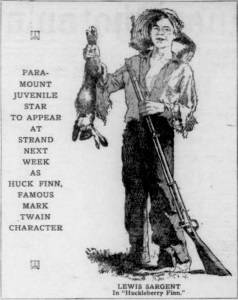
In 1935, Rockwell was offered a new commission that truly sparked his imagination: George Macy, of the Macy Department Stores, wanted to celebrate the centennial of Samuel L. Clemens' birth - better known to the world as Mark Twain - by publishing new versions of Tom Sawyer and Huckleberry Finn. To achieve historical and geographical accuracy, Rockwell decided to explore Hannibal, Missouri (where Twain's stories are set). Rockwell created a photographic record of his trip (a somewhat controversial technique amongst "real" artists at the time) and reread both books. Finally, Rockwell produced 8 color plates for each book which were published in 1936 and 1940 respectively.
In 1939, Norman and Mary moved their family to Arlington, Vermont. Arlington was a country area with many farms, which suited their desire for a more rural existence in which to raise three boys and for Norman to paint in peace. The Rockwell family was happy in their move to Vermont where they had become well acquainted with the townspeople, joined in weekly square dances and attended monthly town meetings.
Late Period and Death
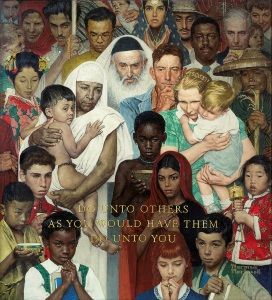
The Japanese attacked Pearl Harbor in 1941 bringing the US into World War II. Rockwell felt that it was his duty to paint images to remind Americans, especially the soldiers, that their freedom and liberty was the most important and valuable possession. His principal inspiration came from President Roosevelt's 1941 address to Congress: "At no previous time has American security been threatened from without as it is today." In 1943, Rockwell painted his Four Freedoms paintings which were reproduced in four issues of the Post accompanied by essays from contemporary writers. The series toured the United States and brought in more than $130 million toward the war effort.
Towards the end of the war, the Rockwell family relocated to an 18th century farmhouse in West Arlington where the artist converted an old barn into a new working studio, his previous studio and all its contents having been destroyed by fire a year earlier. Mary and Norman spent the snowy winter of 1944 hiking and enjoying Vermont but by the fall of 1948, it was clear that Mary had developed a drinking problem. She was lonely and exhausted and struggled to keep up with her duties, especially managing her husband's financial records. Mary sought psychiatric treatment at the private institution Austen Riggs where she received shock treatments during 1952. Norman had also consented to therapy for his own anxiety and frequent bouts with depression and in December 1953, the Rockwells took the joint decision to move to Stockbridge, Massachusetts to be nearer to the treatment center, and to generally enjoy the social and cultural benefits of an urban setting. By spring the family had moved into a new house. Norman had a new studio, and he and Mary began attending live model sketching classes together.
With all three boys in private schools, and the expenses for their own health care mounting, Rockwell needed to generate new income. In the summer of 1955 he began working again for the Post for whom he agreed to paint portraits of the Presidential candidates Adlai Stevenson and Dwight Eisenhower. Meanwhile, in the fall of that year, the publisher Doubleday commissioned Rockwell to write his autobiography (he was 65 at the time). On August 25, 1959, tragedy struck when Mary unexpectedly passed away at the age of 51 from heart failure. Norman was very badly shaken and he became unfocused, disturbed, and depressed. His family and friends rallied around him, but the Post intended to begin publishing excerpts of his autobiography in February 13, 1960, an occasion for which he need to focus on producing the cover image.
Soon thereafter, Rockwell met Molly Punderson, an attractive, 62-year-old, well-educated teacher, from whom he took an adult poetry class at the public library. The couple were married in October 1961. That same year, he was delighted to learn that he had been called "part of the tradition of humorous genre painters dating at least from seventeenth century Holland." His self-esteem soared at being considered a master artist of genre rather than a mere illustrator.
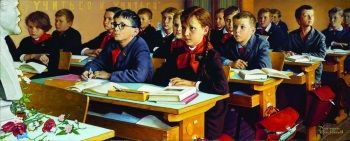
Norman was interested in studying Social Realism and Mary wanted to learn about the Russian school system. Norman had made sketches of the school children on an earlier trip in 1964, and later made the work Russian Schoolroom (1967) that he created in a new (for the artist) photo-realist style.
Between 1963 and 1964, Molly and Norman flew to Russia for a World Fair and then on to Egypt where Rockwell painted the portrait of President Nasser. This would be his last cover for the Post which was in financial decline. Both Look and McCall's magazines were interested in his work but Norman, now aged 69, felt that Look would be more interesting since it included foreign coverage, series about religion and news of southern racial tensions. His 1964 painting for Look, The Problem We All Live With, which tackled the theme of segregation, had a great social impact in the era of the Civil Rights protests.
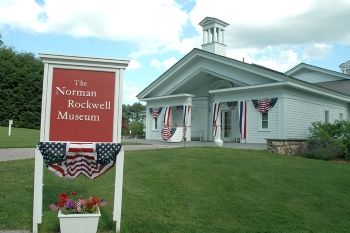
That same year, Molly and other women from Stockbridge, purchased an historical building in which to create a museum/historical society. Rockwell loaned them many paintings and soon the Norman Rockwell Museum in Stockbridge was a viable cultural attraction. Molly also urged her husband to take time to organize his art collection and his estate. When a well-known Manhattan gallery asked him about having a show in the fall, Norman was further energized to organize his many paintings. His first solo exhibition was held in the Bernard Danenberg Gallery in 1968. That fall, Harry Abrams published the first major biography of Rockwell. During the 1970s, the renewed interest in Rockwell's work reflected a general rejection of abstract art. Rockwell made a publicity tour to help promote the book and appeared on several talk shows. By the fall of 1971, he was once again completely exhausted. He had worked through a very hot summer and his August portrait of Frank Sinatra showed a decline in his abilities.
In 1972 The Danenberg Gallery sponsored a traveling show titled "Norman Rockwell: A Sixty-Year Retrospective" which toured nine cities over two years. Audiences were huge even if critical opinion was divided. By the end of August 1973, Rockwell was feeling poorly enough to record his periods of mental fatigue on his calendar. He had suffered from pneumonia for years and X-rays now confirmed that he had emphysema. By 1974, aged 80, Norman suffered a minor stroke. Molly commented on her husband's deteriorating health "I knew Norman wasn't really okay [...] just wasn't always on cue, sometimes fine, other times somehow off." Rockwell's sense of color had also become altered by his cataracts and he became unable to distinguish some ranges of color. On November 8, 1978, Norman Rockwell passed away peacefully in his own bed. David Wood, a family friend and tenant, led a short eulogy beginning with Norman's favorite poem, "Abou Ben Adhem". It is a romantic poem by the British poet James Leigh Hunt about the love of one man for his fellow men which is also a love of God.
The Legacy of Norman Rockwell
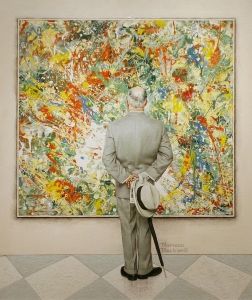
Sneered at by some in the high art community - though admired by the likes of Willem de Kooning and the German painter and satirist George Grosz who praised Rockwell for his "excellent technique, clearness of touch" and a populist instinct that was "so universal that he would be appreciated everywhere" - Rockwell's contribution to American Art has been subject to justified revision. As his biographer Deborah Solomon observed in 2013, New York art sophisticates, and even her own art history professors, were scathing about Rockwell but his art has proved to have "far more staying power than that of countless abstract painters who were hailed in his lifetime." Writing in 1998, meanwhile, New Yorker art critic Peter Schjeldahl, stated: "Rockwell's pictures are literal-minded and sentimental, sure, but they constitute as accurate a graph as we have of what being American - a fictive condition, always - could feel like in the twentieth century. Meanwhile, he spread delight among the people. Last I checked, there wasn't a law against that."
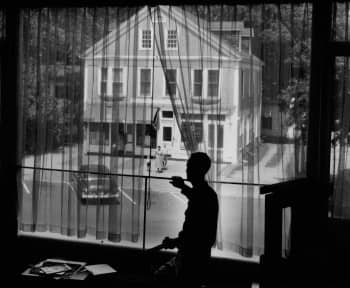
Indeed, Rockwell has had a lasting and profound effect on America's self-image. Arguably the American public's all-time favorite painter - The New York Times once suggested that his work was on a par with Mark Twain's novels in its significance to America's self-image - his images, which are still mass reproduced, are viewed today almost as paeans for a lost age. His images of suburban America in the '20s, '30s, '40s and '50s meanwhile have provided source material for Hollywood directors including George Lucas, Steven Spielberg and Robert Zemeckis whose Oscar winning 1994 film Forrest Gump pays direct homage to Rockwell by recreating several of his paintings as scenes. Rockwell was awarded the Presidential Medal of Freedom in 1977, a year before his death. Today, the Norman Rockwell Museum is home the world's largest collection of his art and is committed to promoting "the power of visual images to shape and reflect society." Its mission statement reads thus: "The Museum advances social good through the civic values of learning, respect and inclusion and is committed to upholding the rights and dignity of all people through the universal messages of humanity and kindness portrayed by Norman Rockwell."
Influences and Connections

-
![Rembrandt van Rijn]() Rembrandt van Rijn
Rembrandt van Rijn - Howard Pyle
- J. C. Leyendecker
- Clyde Forsythe
-
![Realism]() Realism
Realism - The Golden Age of Illustration
- George Lucas
- Steven Spielberg
Useful Resources on Norman Rockwell
- A Rockwell Portrait - An Intimate BiographyBy Donald Walton
- Norman Rockwell - A LifeBy Laura Claridge
- Norman Rockwell, Artist and IllustratorBy Thomas S. Buechner
- Norman Rockwell: IllustratorBy Arthur Guptill
- American Mirror: The Life and Times of Norman RockwellBy Deborah Solomon
- Norman Rockwell's World of ScoutingBy William Hillcourt
